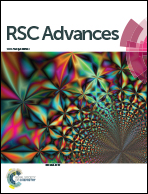Modified carbon paste and polymeric membrane electrodes for determination of hydroxychloroquine sulfate in pharmaceutical preparations and human urine
Abstract
This article describes characteristics, performance and application of hydroxychloroquine (HCQ) polymeric membrane (PMEs) and modified carbon paste (CPEs) electrodes which are based on sodium tetraphenylborate (NaTPB) or ammonium reineckate (Rt) as sensing materials. These electrodes showed Nernstian slopes of 29.1 ± 0.2, 28.5 ± 0.4, 28.0 ± 0.5 and 27.5 ± 0.5 mV decade−1 at 25 ± 0.1 °C, with low detection limits of 7.9 × 10−6, 8.2 × 10−6, 6.5 × 10−6 and 5.0 × 10−6 mol L−1 HCQ for PME1, PME2, CPE1 and CPE2 electrodes, respectively. The constructed electrodes were found to be precise and usable within the pH range of 2–8, 2–7, 2–8 and 2–7 for the electrodes, respectively. The electrodes manifest advantages of low resistance, very short response time ≤10 s, and most importantly good selectivity with respect to a number of common inorganic and organic species. Modified carbon paste electrodes showed lower detection limits reaching 5.0 × 10−6, higher thermal stability (0.0010 mV °C−1) and longer life time (54 days) than those of polymeric membrane electrodes. The electrodes were used for determination of hydroxychloroquine in its pure state, pharmaceutical preparation of hydroxychloroquine and biological fluids such as human urine samples.


 Please wait while we load your content...
Please wait while we load your content...